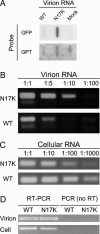Single point mutations in the zinc finger motifs of the human immunodeficiency virus type 1 nucleocapsid alter RNA binding specificities of the gag protein and enhance packaging and infectivity
- PMID: 15919928
- PMCID: PMC1143677
- DOI: 10.1128/JVI.79.12.7756-7767.2005
Single point mutations in the zinc finger motifs of the human immunodeficiency virus type 1 nucleocapsid alter RNA binding specificities of the gag protein and enhance packaging and infectivity
Abstract
A specific interaction between the nucleocapsid (NC) domain of the Gag polyprotein and the RNA encapsidation signal (Psi) is required for preferential incorporation of the retroviral genomic RNA into the assembled virion. Using the yeast three-hybrid system, we developed a genetic screen to detect human immunodeficiency virus type 1 (HIV-1) Gag mutants with altered RNA binding specificities. Specifically, we randomly mutated full-length HIV-1 Gag or its NC portion and screened the mutants for an increase in affinity for the Harvey murine sarcoma virus encapsidation signal. These screens identified several NC zinc finger mutants with altered RNA binding specificities. Furthermore, additional zinc finger mutants that also demonstrated this phenotype were made by site-directed mutagenesis. The majority of these mutants were able to produce normal virion-like particles; however, when tested in a single-cycle infection assay, some of the mutants demonstrated higher transduction efficiencies than that of wild-type Gag. In particular, the N17K mutant showed a seven- to ninefold increase in transduction, which correlated with enhanced vector RNA packaging. This mutant also packaged larger amounts of foreign RNA. Our results emphasize the importance of the NC zinc fingers, and not other Gag sequences, in achieving specificity in the genome encapsidation process. In addition, the described mutations may contribute to our understanding of HIV diversity resulting from recombination events between copackaged viral genomes and foreign RNA.
Figures







Similar articles
-
Strict conservation of the retroviral nucleocapsid protein zinc finger is strongly influenced by its role in viral infection processes: characterization of HIV-1 particles containing mutant nucleocapsid zinc-coordinating sequences.Virology. 1999 Mar 30;256(1):92-104. doi: 10.1006/viro.1999.9629. Virology. 1999. PMID: 10087230
-
Role of distal zinc finger of nucleocapsid protein in genomic RNA dimerization of human immunodeficiency virus type 1; no role for the palindrome crowning the R-U5 hairpin.Virology. 2001 Mar 1;281(1):109-16. doi: 10.1006/viro.2000.0778. Virology. 2001. PMID: 11222101
-
Mapping of nucleocapsid residues important for HIV-1 genomic RNA dimerization and packaging.Virology. 2008 Jun 5;375(2):592-610. doi: 10.1016/j.virol.2008.02.001. Epub 2008 Mar 17. Virology. 2008. PMID: 18343475
-
HIV-1 gag proteins: diverse functions in the virus life cycle.Virology. 1998 Nov 10;251(1):1-15. doi: 10.1006/viro.1998.9398. Virology. 1998. PMID: 9813197 Review.
-
How retroviruses select their genomes.Nat Rev Microbiol. 2005 Aug;3(8):643-55. doi: 10.1038/nrmicro1210. Nat Rev Microbiol. 2005. PMID: 16064056 Review.
Cited by
-
Specificity of the HIV-1 Protease on Substrates Representing the Cleavage Site in the Proximal Zinc-Finger of HIV-1 Nucleocapsid Protein.Viruses. 2021 Jun 8;13(6):1092. doi: 10.3390/v13061092. Viruses. 2021. PMID: 34201134 Free PMC article.
-
How HIV-1 Gag Manipulates Its Host Cell Proteins: A Focus on Interactors of the Nucleocapsid Domain.Viruses. 2020 Aug 13;12(8):888. doi: 10.3390/v12080888. Viruses. 2020. PMID: 32823718 Free PMC article. Review.
-
Molecular modeling and analysis of hepatitis E virus (HEV) papain-like cysteine protease.Virus Res. 2014 Jan 22;179:220-4. doi: 10.1016/j.virusres.2013.11.016. Epub 2013 Dec 7. Virus Res. 2014. PMID: 24321124 Free PMC article.
-
Transduction of human immunodeficiency virus type 1 vectors lacking encapsidation and dimerization signals.J Virol. 2007 Oct;81(19):10687-98. doi: 10.1128/JVI.00653-07. Epub 2007 Jul 25. J Virol. 2007. PMID: 17652403 Free PMC article.
-
Human Retrovirus Genomic RNA Packaging.Viruses. 2022 May 19;14(5):1094. doi: 10.3390/v14051094. Viruses. 2022. PMID: 35632835 Free PMC article. Review.
References
-
- Amarasinghe, G. K., R. N. De Guzman, R. B. Turner, K. J. Chancellor, Z. R. Wu, and M. F. Summers. 2000. NMR structure of the HIV-1 nucleocapsid protein bound to stem-loop SL2 of the psi-RNA packaging signal. Implications for genome recognition. J. Mol. Biol. 301:491-511. - PubMed
-
- Amarasinghe, G. K., J. Zhou, M. Miskimon, K. J. Chancellor, J. A. McDonald, A. G. Matthews, R. R. Miller, M. D. Rouse, and M. F. Summers. 2001. Stem-loop SL4 of the HIV-1 psi RNA packaging signal exhibits weak affinity for the nucleocapsid protein. structural studies and implications for genome recognition. J. Mol. Biol. 314:961-970. - PubMed
Publication types
MeSH terms
Substances
LinkOut - more resources
Full Text Sources
Other Literature Sources

